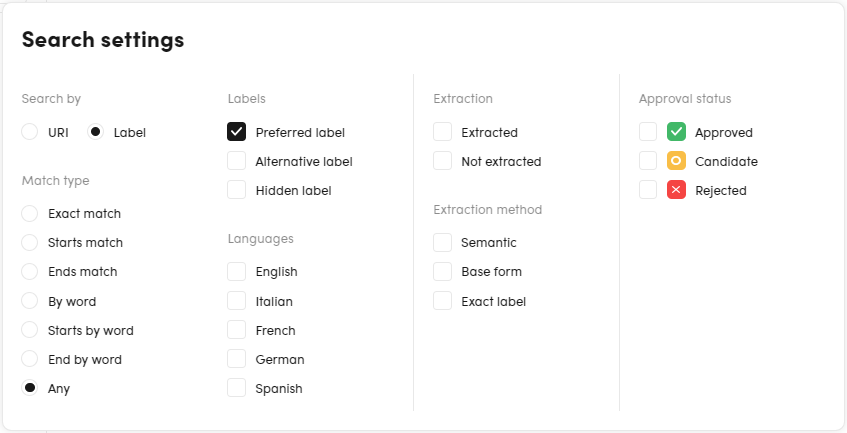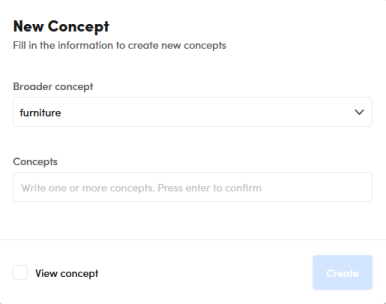Taxonomy basics
A tree of concepts
In a thesaurus project, the taxonomy is visualized as a tree whose nodes represent concepts.

The tree hierarchical structure corresponds to the narrower/broader relation between concepts: if you look at the relation from a node to its children, the child nodes are narrower concepts, if you look at the relation the other way, from child to parent, the parent node is a broader concept.
First-level nodes don't have parent nodes. so they are considered children of the tree root which is conventionally labelled Thesaurus.
The same concept can appear in several locations of the tree: it can have more than one broader concepts and so be the child of more than one node.
The concepts of a thesaurus can also be related to each other in non-hierarchical relations. According to the SKOS formalization, these concepts are related but the type of relation is not specified. This kind of relation is not displayed in the tree visualization.
The tree of concepts is displayed in the Resources panel of the Resources tab of the project dashboard. In the tree, a node's label is the preferred label of the corresponding concept for the favorite project language.
Expand and collapse tree nodes
-
To toggle the display of direct child nodes use the right arrow
 and the down arrow
and the down arrow  to the left of the parent node.
to the left of the parent node. -
To toggle the display of the fully expanded subtree, hover over the concept node and select Expand node
 or Collapse node
or Collapse node  .
.
Find concepts
A way to find concepts is typing in the search box and pressing Enter. The tree view is replaced by a list of concepts matching whatever you typed. Each result contains basic information about the concept.

To cancel the search select the X icon  in the search box.
in the search box.
To check and change the settings that determine how the search works and to access additional ways to find concepts, select the gear icon  in the search box. The Search settings dialog will appear.
in the search box. The Search settings dialog will appear.

-
In the left part of the dialog you find the settings affecting the match between what you type in the search box and the concepts attributes.
- In the Search by area, select URI or Label to match the string you type with concepts' URIs or labels.
- If you choose Label, you can then select which labels—preferred, alternative, hidden—to match in the Labels area. Multiple selection is allowed.
-
In the Match type area you can select the match criteria, that is where in the label (or URL) the string you type will be searched for. Based on the criteria, the labels or URIs must:
- Exact match: be exactly equal to the typed string.
- Starts match: start with the typed string.
- Ends match: end with the typed string.
- By word: contain one or more words that exactly match the typed string.
- Starts by word: contain one or more words that start with the typed string.
- End by word: contain one or more words that end with the typed string.
- Any: contain the typed string, no matter where.
-
In the Languages area, displayed only in multi-language projects, you can select the language of the labels to match. Multiple selection is allowed.
In the other divisions of the dialog you find filters that have immediate effect and work also if you didn't type anything in the search box.
- In the Extraction area you can filter concept based on them being marked as to be extracted by models or not.
- In the Extraction method area you can filter concepts on their extraction method.
- In the Approval status area you can filter concepts based on their approval status.
Select a concept in the list of results to open it in the Edit concept panel.
Add concepts
The New concept dialog
Whenever you create new concepts from scratch (see below) the New concept dialog appears.

In the Concepts field you will find any label already typed before opening the dialog. If the field is empty:
- Type a label and press
Enter. - Repeat to create more concepts at once.
The specified labels will be considered the preferred labels of the new concepts.
In the Broader concept field you can specify a broader concept for the new concepts.
If you do, the new concepts will be displayed as child nodes of the indicated concept in the taxonomy tree, otherwise the new concepts will be displayed under the root of the tree, they will not have a parent node.
If the field is empty, to specify the broader concept start typing, Concepts with matching labels are displayed in a drop-down list and you can choose the broader concept from it.
If you select View concept, the new concept (or the one corresponding to the first label, in case of multiple concepts) becomes the current concept shown in the Edit concept panel
To confirm the creation of the new concept select Create. To cancel the operation click anywhere outside the dialog.
Add concepts from the Resources panel
To create a first-level concept under the root of the tree:
- Select the plus icon
 on the toolbar of the Resources panel.
on the toolbar of the Resources panel.
Or:
- Hover over Thesaurus and select Create concept
 .
.
To create narrower concepts for an existing concept:
- Select the broader concept or hover over it and choose Create concept
 .
.
Use the New concept dialog to define the new concept.
Add concepts from the Edit concept panel
- Select a concept in the tree of the Resources panel.
- Select the Relations tab inside the Edit concept panel.
-
Select the plus button under:
- BROADER CONCEPTS if you want to create a broader concept, that will be displayed as a parent node in the tree.
- NARROWER CONCEPTS if you want to create a narrower concept, that will be displayed as a child node.
- RELATED CONCEPTS if you want to create a non-hierarchically related concept, that will be displayed in the tree as you'll decide later.
The Find concept field appears.
-
Type in the Find concept field. Existing concepts with matching labels are listed below while you type.
-
Choose an existing concept from the list to create a relation between concepts.
Or:
Select Create new "label" or press
Enterto create a new concept with the label you typed. Use the New concept dialog to define the new concept.
Add concepts using suggestions
You can use automatic suggestions to define new concepts, read the article dedicated to this topic to learn how.
Add concepts during annotation
Read the article about annotating expected results to learn about adding concepts during annotation.
Add concepts from knowledge sources and other projects
Read the articles about:
to know how to add concepts using other thesauri.
Edit concepts
Read the articles in the section devoted to the topic to learn how to edit concepts and their relations with other concepts.
Move concepts
To move a concept node within the tree, drag it over its new parent concept.
Moving a concept changes one&mdah;possibly the only—broader-narrower relation of the concept, but doesn't affect other relations.
Delete concepts
Warning
When you delete a concept, all the subtree gets deleted. If what you want is to break the link between two concepts without deleting concepts, you have to delete relations.
To delete a concept:
- Select the concept in the Resources panel, then select Delete concept
 .
.
Or:
- Hover over the concept in the Resources panel, then select Delete concept
 .
.
Or:
- Select the concept in the Resources panel.
- Select Delete concept
 on the Edit concept panel toolbar.
on the Edit concept panel toolbar.
To delete multiple concepts at once:
Ctrl+Clickinside the Resources panel to select the concepts to delete.- Select Delete concepts in the central part of the page.
Delete relations
Info
Deleting a relation between two concepts doesn't delete any concept or any other relation. If you delete the only broader-narrower relation between two concepts, the ex narrower concept becomes a child of the root concept of the tree.
- In the Resources panel select a concept that is related to the concept to delete.
- Select the Relations tab of the Edit concept panel.
- Hover over the concept for which you want to delete the relation under BROADER CONCEPTS , NARROWER CONCEPTS or RELATED CONCEPTS then select the X icon
 .
.